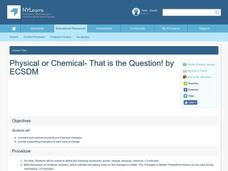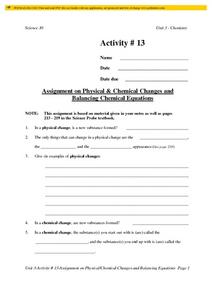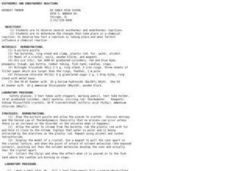Curated OER
Physical or Chemical- That is the Question!
Learners observe the differences between physical and chemical changes in properties. Through the use of an interactive presentation, the students compare and contrast the changes and provide supporting examples of each type of change.
Curated OER
Breathing Victory
Students know that participation in sports requires energy. They comprehend that we get energy form the foods that we eat and the air thta we breathe. Converting food and air into usable energy is defined as celluar respiration. Students...
American Chemical Society
Conservation of Mass
It may take up less space, but the mass stays the same. Tackle a common misconception about conservation of mass using a hands-on instructional activity. Learners measure the mass of substances before and after melting, dissolving, and...
American Chemical Society
What’s the Difference between Baking Soda and Baking Powder?
Introduce pupils to chemical reactions. Using the hands-on lesson, learners experiment with substances that combine to form a gas. Different substances react to form different amounts of gas, leading to a discussion about the particles...
American Chemical Society
Engineering a Floatation Device
Classes will definitely not be sinking after a buoyant lesson! A project-based assessment helps highlight the importance of prior knowledge as individuals design a floatation device for a cell phone. They use their knowledge of chemical...
Curated OER
Reactions of Benzene Derivatives
In this reactions of benzene derivatives, students write the structural formulas for the products of 3 chemical reactions and show multiple steps if necessary.
Curated OER
Chemical Reactions with Vinegar
Fifth graders create their own volcano. In this science lesson, 5th graders build a "volcano" using vinegar and baking soda. They observe and analyze outcomes, and define a chemical reaction.
Kenan Fellows
Balancing Equations Using Matrices
Matrices help solve systems of equations in chemistry, computer graphics, circuitry, probability, and more. The second lesson in a seven-part series focuses on using matrices to balance chemical equations. Pupils rely on the Law of...
American Chemical Society
Formation of a Precipitate
Conclude this chemical change unit by having your class combine two liquids that result in formation of a precipitate. The learners discover that chemical reactions result in new materials. Make sure to consider all of the preceding...
Curated OER
Quite a Reaction
For this chemical reaction worksheet, students experiment with soda and Mentos candy to observe a chemical reaction. Students describe the reaction, identify the investigation as descriptive or qualitative and make a prediction if the...
Curated OER
Heat Loss and Gain in Physical Changes and Chemical Reactions
Pupils measure the heat of physical and chemical changes in reactions. In this chemistry lesson students determine at what extent changes emit or absorb heat.
Curated OER
Physical and Chemical Changes and Balancing Chemical Equations
In this changes worksheet, pupils compare and contrast the characteristics of physical and chemical changes. Students practice balancing equations. This worksheet has 5 fill in the blank and 7 short answer questions.
Curated OER
Equilibrium Practice
In this chemical reactions worksheet, students determine solubility product expressions, equilibrium constants, and equilibrium concentrations. This worksheet has 15 multiple choice questions and 3 problems to solve.
Curated OER
Ice Energy
Students investigate how salt affects the state of ice. In this ice cream making lesson plan, students change the freezing temperature by adding salt and observing the results. Students use experimentation and comparison to see how...
Curated OER
Stomach Chemistry
Fifth graders compare physical and chemical changes. They perform a simulation experiment/activity that replicates what happens in the stomach as food is digested by stomach acids.
Curated OER
Stoichiometry
Students discover stoichiometric relationships in chemical equations. They review mole to mole conversions. They understand mass/particle conversions. They perform a lab to reinforce stoichiometry.
Curated OER
Exothermic and Endothermic Reactions
Students observe demonstrations of exothermic and endothermic reactions and determine the changes that take place in a chemical reaction. Students observe four demonstrations showing entropy, attraction of molecules due to polarity,...
Curated OER
Physical vs. Chemical Changes
In this chemical and physical change worksheet, students are given details about chemical and physical changes. They are given 2 examples using water and salt and they identify 15 statements as chemical or physical changes. Students...
Virginia Department of Education
The Law of Conservation of Matter
The Law of Conservation of Matter can be complex for young scientists to fully grasp. Use this experiment to help simplify the process as pupils perform two experiments to determine mass: one that melts a substance and the other that...
NOAA
Ocean Zones
How can organisms light up in water? Bioluminescence is light produced in a chemical reaction that can occur in an organism's body. First, learners determine what happens to light/color as you move into the deep ocean. In groups, they...
Curated OER
Condensation Polymerization: Preparation of Two Types of Polyesters
College-level or AP chemists use phthalic anhydride to synthesize two different polyesters, one linear and one cross-linked in structure. A detailed materials list and well-written procedures are provided on a lab sheet. Learners write...
Curated OER
Heat Loss and Gain in Physical Changes and Chemical Reactions
Students compare and contrast exothermic and endothermic reactions. In this chemistry lesson, students perform experiments to determine whether heat was released or absorbed in a reaction. They share their observations in class.
Curated OER
Matter
Eighth graders explore chemical reactions and their products. They define a chemical reaction and describe the characteristics of a chemical reaction. Students classify chemical reactions.
Curated OER
Speed me up, Scotty!
Students describe and define chemical reactions. They design a laboratory experiment, collect data and analyze data.
Other popular searches
- Chemistry Chemical Reactions
- Types of Chemical Reactions
- Balance Chemical Reactions
- Chemical Reactions of Matter
- Balancing Chemical Reactions
- Rates of Chemical Reactions
- Chemical Reactions Labs
- Rapid Chemical Reactions
- Catalyst Chemical Reactions
- Chemical Reactions Cement
- Chemical Reactions Air Bags
- Classifying Chemical Reactions

























